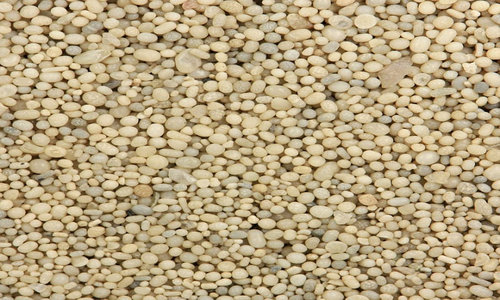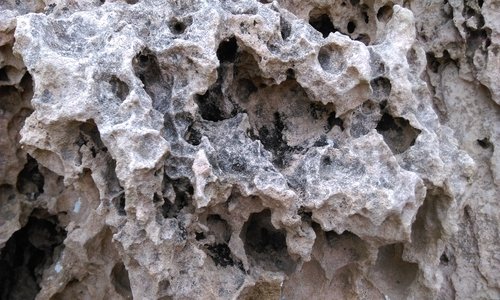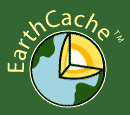Along this 5km section of the wonderous Great Ocean Road is the spectacular, but hazardous, Demons Bluff and Point Roadknight.
Point Roadknight is a narrow ridge of dune calcarenite that parallels the adjoining Urquhart Bluff Beach. The point and its reef protrude 500 m to the east and afford considerable protection to the beach.
Demons Bluff, as the name suggests, is a sheer, 30 to 50 m high, eroding cliff, fronted by a narrow, 1.5 km long beach that is awash at high tide.
Calcarenite is a type of limestone that is composed predominantly, more than 50 percent, of detrital (transported) sand-size (0.0625 to 2 mm in diameter), carbonate grains. The grains consist of sand-size grains of either corals, shells, ooids, intraclasts, pellets, fragments of older limestones and dolomites, other carbonate grains, or some combination of these.

Calcarenite
Oolite is a sedimentary rock made up of ooids (ooliths) that are cemented together. Most oolites are limestones. Ooids are made of calcium carbonate (minerals aragonite or calcite). Ooids are spheroidal grains with a nucleus and mineral cortex accreted around it which increases in sphericity with distance from the nucleus. Nucleus is usually either mineral grain or biogenic fragment. The term “ooid” is applied to grains less than 2 mm in diameter. Ooids usually possess a clearly developed growth banding. Ooids may be spherical but some are elongated, depending on the shape of nucleus. Most ooids are marine, forming in shallow (less than 10 m, preferably even less than 2 meters), warm, and wave-agitated water.

Oolite
Calcarenites can accumulate in a wide variety of marine and nonmarine environments. They can consist of grains of carbonate that have accumulated either as coastal sand dunes (eolianites), beaches, offshore bars and shoals, turbidites, or other depositional settings.
Eolianite or aeolianite is any rock formed by the lithification of sediment deposited by aeolian processes; that is, the wind. In common use, however, the term refers specifically to the most common form of eolianite: coastal limestone consisting of carbonate sediment of shallow marine biogenic origin, formed into coastal dunes by the wind, and subsequently lithified. It is also known as kurkar in the Middle East, miliolite in India and Arabia, and grès dunaire in the eastern Mediterranean. They are understood to have formed during the last one million years, and it is thought that the timing of deposition is related to sea level, but the nature of that relationship remains the subject of some debate.
The most extensive deposits of eolianite in the world are located on the southern and western coasts of Australia. On the west coast, there are over 800 kilometres (500 mi) of eolianite cliffs, which are over 150 metres thick in some places.

Eolianite
Questions
Q1 From the posted coordinates, describe what is happening here to the rock and what colours do you see.
Q2 WP2 will bring you out to the narrow ridge, describe the rock and colours you see here. Also describe the layers and what they look to be doing.
Q3 WP3 will bring you to an obvious erosion in the rock above head height. Describe it in your own words.
Now either take a nice walk along the beach or move the car to the second parking coordiantes for Q4.
Q4 WP4 will bring you to the Demons Bluff. Describe the layers, how many do can you count and from upclose, how does the sediment appear. Does it look different than you first thought it would from a distance.
Once you complete the EarthCache requirements you can post your find without delay, as per the EarthCache guidelines. You will also need to verify your find by sending me a message and provide your answers to the questions.
For a link to my profile, click here - Na'wal
Thanks for visiting this Earth Cache. Hope you enjoy the location.

Feel free to attach photos to your log (optional)

References ~ Parks Victoria, VRO, Wikipedia & Sandatlas